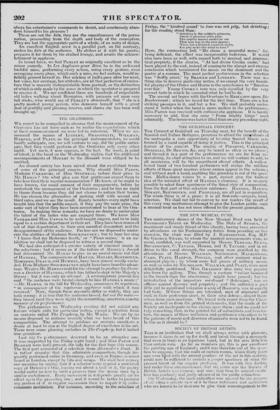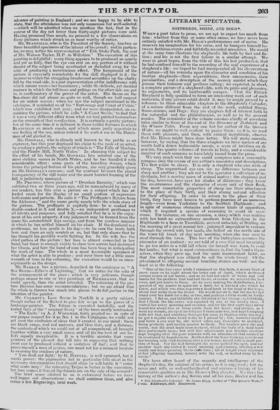SOCIETY OF BRITISH ARTISTS.
Tins is an institution that we shall always notice with pleasure, because it dares to set up for itself, and break through a monopoly that even in trade is an injurious bond, but in the arts little less than certain ruin. As far as numbers go, this is par excellence the painting age of England ; and it was therefore out of the gees- tion to suppose, that the walls of certain rooms, which thirty years ago were filled with the annual produce of the art in this country. could now te sufficient to contain a proper specimen of what the present talent of the empire produces; It was with this feeling', and under these circumstances, that six years ago the Society of British Artists was formed; and since that time its annual exoibi tion has gradually and justly advanced in the public estimation. On Wednesday, the sixth exhibition was opened for tile purpose of affording a private view of it to those noblemen and g,enttemen who are known to be desirous to give their encouragement to the advance of painting in England ; and we are happy to be able to state, that the attendance was not only numerous but well-seleeted, —which will be admitted when we mention the fact, that in the course of the day not fewer than thirty-eight pictures were sold. . Having premised thus much, we proceed to a few observations on those pictures which struck us as most worthy of notice. Mr. STANFIELD, who is the President of the Society, has two or three beautiful specimens of the labour of his pencil ; and in particu- lar, we may notice his representation of " Erie Stoke Park, the seat of Mr. Watson Taylor, M.P. in Wiltshire." The execution of this painting is delightful : every thing appears to be produced so quietly and yet so fully, that the eye can rest on any portion of it without danger of the subject being overloaded or dwindled away for the sake of producing a meretricious effect. The foreground of the picture is especially remarkable for the skill displayed in it : the manner in which the straggling brushwood scrambles up the chalky hill by the road-side, is a just representation of the indifference with which nature wastes her luxuriance ; while the delicate, yet decided manner in which the tall trees and palings on the other side are put in, is confirmatory of the power of the artist. His Scene on the Sea-shore did not please us quite so well, though we half suspect for an unfair reason : when we saw the subject mentioned in the catalogue, it reminded us of his "Fort-rouge and Coast of Calais." which -was exhibited last year; and we were disappointed, on ex- aminieg the picture, which he calls "A Coast Scene," to find that it was a very different affair from what we had painted to ourselves on the strength of that recollection. It is certainly a pretty picture; but at the same time it is deficient in those bolder features in which ST.kNFTELD so much excels, and which more justly appertain to our feeling of the sea, unless indeed it be such a sea as the Dutch- men of old gloried in.
Mr. GOODALL, who is already well known to the public as an engraver, has this year displayed hisclaim to the rank of an artist, by sendinga picture, the subject of which is "The Falls of Machno, and the Pandw Mill„ North Wales." In choosing this subject for the effort of his brush, Mr. GOODALL has selected one of the most striking scenes in North Wales, and he has handled it with considerable effect: some parts of the brawling stream, which forms the principal feature of his picture, are very gracefully given on Mr. GOODALL'S Canvass; and the contrast between the placid transparency of the still water and the mord hurried foaming of the fall, is judiciously managed. Mr. PRENTIS, whose picture of "Drunken Barnaby," which was exhibited two or three years ago, will be remembered by many of our readers, has this year a picture on a subject which has af- forded room for the display of no small portion of expression both comic and pathetic. He calls it "The Profligate's Return from the Alehouse ; ' and the name pretty nearly tells the whole story of i the picture. The profligate s capitally done: he is soaked and double-soaked in X and double X,—an independent gentleman to all intents and purposes, and fully satisfied that he is in the enjoy- ment of his own property, if any judgment may be formed from the space his outstretched legs occupy, and from the careless manner in which he has settled himself on his chair. If the drunkard is a gentleman, no less gentle is his dog ;--to be sure the brute hath here and there an ugly scratch or so, but that only shows that he has thought his gentility worth fighting for. In the wife lies the chief pathos of the picture : her face is almost concealed in her hand, but there is enough visible to show how sorrow had destroyed her bloom, and how the hand of care has been busy in anticipating the work of time. The whole is a most favourable specimen of what the artist is able to produce: and were there but a little more warmth of tone in the colouring, the execution would be as unex- ceptionable as the design.
Mr. BARKER has a picture, described in the catalogue as "A Sea Storm—Effects of Lightning," that we notice for the sake of the arrangement of the piece ; which is very judicious, though perhaps nearer to one er two paintings of REMBRA.NDT, that we could specify, than the artist intended. The colouring of the pic- ture likewise has some recommendations ; but we are afraid that the whole is thrown too much into gloom to do full justice to the intention of the painter. Mr. COLKETT.S Lane Scene in Norfolk is a pretty subject, though rather of the flattest to give fair scope to the power of a landscape-painter. The foliage is executed tastefully, and the varied tints of the "summer livery" of the trees neatly contrasted. "The Exile," by A. J. WOOLMER, fairly puzzled us : in spite of our proper respect for it as No. I in the Catalogue, we could not get over the confusion of ideas that it created in our mind : there are black crags, and red meteors, and blue tints, and a distance, the contents of which we could not at all comprehend, all brought together within a very small space, and all (to the best of our be- lief) equally inexplicable. It is a terrible mistake that some painters of the present day fall into in supposing that nothing great can be produced without a violation of fact ; and that to prove oneself a man of genius, one must not for a moment hesitate to overstep the confines ofnature.
"You shall not fight," by G. HAVELL, is well arranged, but it wants power: the pugnacious lad in particular falls short in the necessary determination that should show he will battle it " come what come may:" the retreating Trojan is better in the execution, but how comes it that all the friends are on the side of the coward?
The brief. space allotted to us is exhausted before we have well begun our observations : we shall continue them, and also notice a few Engravings, next week.



















 Previous page
Previous page